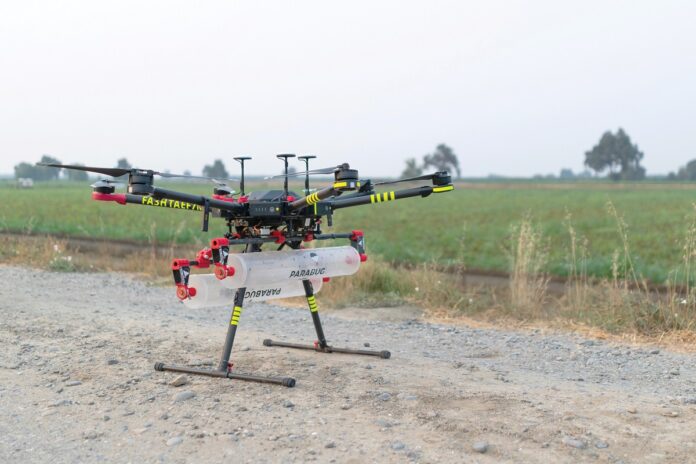For an industry that sprang from remote mountain farms and rundown warehouses, the cannabis industry has come a long way over the past decade in applying new technologies to cultivation and manufacturing. Tasks that once required demanding manual labor and long hours now are accomplished with the touch of a button on a mobile phone.
Much like their counterparts in farming and manufacturing, cannabis entrepreneurs are becoming increasingly reliant on new technologies to upgrade and fine-tune their processes. Any inefficiency in production can have dire consequences as the competition continues to grow and profit margins continue to shrink.
For now, new technologies are playing the biggest role in cultivation and post-harvest operations, but soon nearly every aspect of cannabis production will be retooled to match the pace of progress in an industry that’s growing faster than ever.
Drones waging biowarfare
As the United States continues to drag its feet on legalizing cannabis, the plant has been federally legal in Canada for almost three years. The industry there maintains some of the largest, most technologically advanced grow rooms in the world. Tweed Inc., a division of Canopy Growth Corporation, opened one of the first industrial-sized, automated grows in 2013. The facility became Canopy’s flagship cultivation operation. Ryan Douglas oversaw the design and management of that facility and since has been building and fine-tuning large-scale greenhouse operations in countries around the world. With more than twenty-five years of experience in the commercial greenhouse industry, Douglas was new to cannabis when he joined Tweed and helped launch the Canadian industry.
“In 2013, it was probably the first time I really integrated advanced technologies, because for the first time it was legal and we had companies that raised money. It was the first time we really incorporated advanced greenhouse technology in the commercial cannabis industry,” he said. “One of the most important pieces of technology is the environmental control software that allows growers to monitor and control everything that’s happening in the entire facility. You can dial down right into the grow room and control temperature and humidity, carbon dioxide, lighting, airflow, even the HVAC system. As long as you have a WiFi connection, you can monitor and control that from anywhere in the world.”
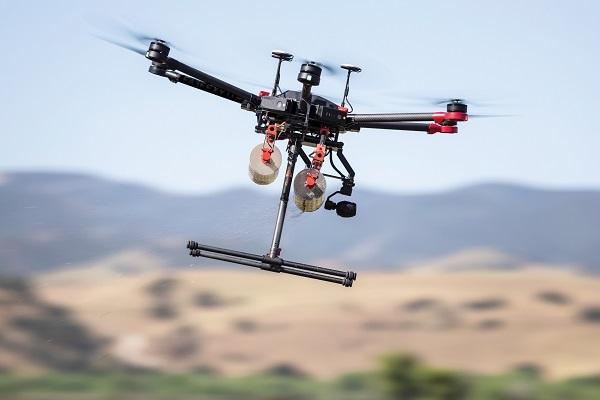
But that was just the beginning of automation and high tech in the cannabis industry. Today, entrepreneurs are developing customized and off-the-shelf solutions to automate and refine their operations from the ground up. Douglas sees a particularly bright future for drones, which could be utilized in a variety of critical functions in grow operations once more service providers develop appropriate applications and services. Drones could become valuable tools for soil analysis, crop mapping and surveying, seed planting, irrigation management, flowering cycle interruption, and pest and disease management, to name but a few.
“I expect drones will become incorporated much more intimately in operations in the future when you consider there’s going to be more and more outdoor cannabis cultivation,” he said. “When we look at how they’re used for other agricultural applications like soil preparation and crop monitoring, it’s going to be a pretty seamless integration to use drones for those same kind of techniques in cannabis.
“But what gets me excited are the new applications,” he continued. “Can they be used to help growers who are indoors or in greenhouses? Because that’s definitely new and not so common with traditional horticulture.”
On the central coast of California, Salinas-based Parabug LLC has been using drones to conduct biowarfare on outdoor cannabis farms for the past six years. The company works with traditional agriculture farms across the U.S., but cannabis cultivators represent a growing client base on the West Coast.
With more and more hemp cultivation and outdoor growers, I think it’s just a question of time before we see drones move to the forefront of the discussion.
—Jaclyn Bennett, GM, Parabug LLC
On the company’s website, drones equipped with cylinders are pictured dropping beneficial insects with tiny parachutes, but apparently that technology is not yet available. Rather, heavy-duty drones fly about ten feet to twenty feet above the crops, and a rotating drum releases different types of bugs, which hit terminal velocity as they latch onto pieces of vermiculite to buffer their fall.
“The easiest way to explain it is like a saltshaker,” said General Manager Jaclyn Bennett. “When you tip over a saltshaker a little bit comes out, but then it’ll stop and you have to shake it again in order to get more salt to come out. That rotation keeps a uniform amount of material and insects coming out and keeps them evenly distributed while it’s rotating.”
The Parabug drones drop between 20,000 and 30,000 predatory mites per acre for cannabis and organic crops; the type and volume depend on which predators are in play and how serious the infestation. “We release a lot of predatory mites—different species depending on the pest and the region they’re in. In hotter climates, we’ll go with more heat-tolerant mites, and in cooler climates we can go with more like a [Phytoseiulus] persimilis mite that likes the coastal weather. A lot of the time we use lacewings, which are a great generalist predator.”
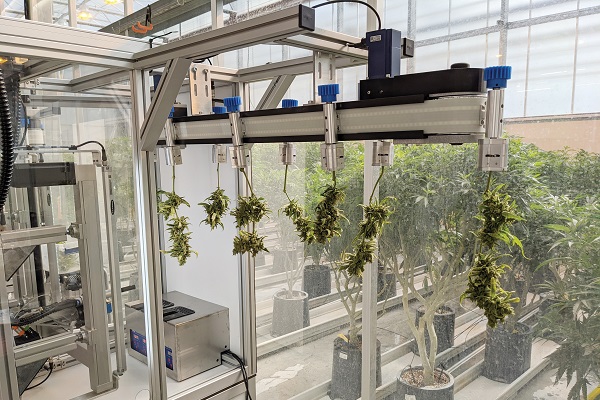
For a variety of reasons, the company hasn’t used its drones in indoor or greenhouse operations yet. One of the main challenges drones encounter in those environments is propellers stir up the air and can spread mold and pests to other parts of grow rooms. Likewise, the drones often have issues with metal interfering with transmission signals. Eventually, that could be solved with smaller drones and new technology that eliminates signal interference.
Douglas thinks it’s only a matter of time before more cannabis farmers are using drones in a variety of applications. “I think it’s a lack of information; I just don’t think it’s in the realm of discussion in the cannabis world, which is still a relatively new industry,” he said. “You still have more people growing indoors and in greenhouses than you have outdoors, but with more and more hemp cultivation and outdoor growers, I think it’s just a question of time before we see drones move to the forefront of the discussion.”
Robots in the trim room
One of the most tedious, mundane jobs in the cannabis industry is trimming. Each new harvest season growers are presented with new-fangled trim machines meant to make trimming easier, and the equipment usually is met with a mixture of curiosity and ambivalence. Many cultivators who grow high-end boutique cannabis are particularly skeptical about industrial machines that use tumblers and blades to slice and dice their buds, discarding precious trichomes in the process. Boston-based Bloom Automation hopes its customized robots will give cultivators more confidence in machine-based trimmers and pave the way for robotics to take over more of the dirty work in the industry.
“There’s a number of reasons we believe robotics should take the job of dull, dangerous, and repetitive tasks so growers can use individuals for more flexible jobs,” said Jon Gowa, founder and chief executive officer. “That would free up some labor, and of course there are other factors too. Fewer hands are touching the plant, so there’s less possibility for contamination.”
Before anyone starts picturing R2D2 or Edward Scissorhands clipping a pile of buds, it’s best to understand the Bloom robots were built with a form-follows-function design philosophy. The robots are aluminum-framed machines with plexiglass siding and stand about six feet tall by six feet wide. They employ a conveyor to feed upside-down cannabis branches into the trim zone. There, the robots scan the branches with a pair of cameras before algorithms take over and analyze where the sugar and fan leaves stop and the bud proper begins. Gowa compared the cutter to an old-fashioned lawnmower blade about the size of a thumb that spins around while a vacuum hose sucks up the material as it’s clipped. Each robot is about twice as fast as the average human trimmer and can methodically manicure about two pounds of bud per eight-hour shift. In a typical 20,000-square-foot operation, one employee can manage a team of six robots, Gowa said.
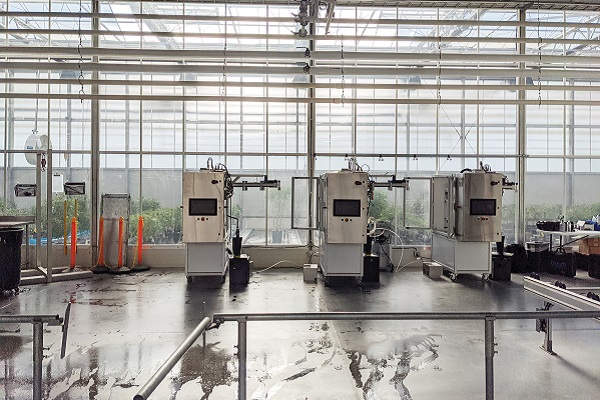
Given the up-front equipment, setup, and training costs, he estimates the return on investment is about sixteen to eighteen months. He also said in the future, post-harvest automation machines will become standard in most large-scale grow facilities. Bloom has been testing its robots in a licensed facility in the U.S. and plans to install them in a few more operations this spring and summer. Gowa envisions robots playing an integral role in a seamless, automated production process.
“On the post-harvest side, we’re looking at how to connect robots together, as opposed to having their own individual conveyor and an operator that loads six of them,” he explained. “Now there’s a conveyor that goes down the line, branching off to each robot, and there’s either one operator for, like, twenty robots—or no operators. You bring [branches] right down the line on a conveyor toward our trimmers or toward your dry room, whichever you do first, and then it’s a continuous conveyor, kind of like a laundromat, where plants are flowing through the trimmers and then into the dry room. And they’re still on the conveyor for seven days in the dryer room, and they come back out to be burped and packaged.
“I certainly see it as feasible—and also necessary, as every other industry uses automation for higher efficiencies,” he added. “People already are going to automated weighing and packaging, so this is just another cog in that line.”
Artificial intelligence
While robotics and drones are just making their debut in the cannabis industry, other technologies are more established and already having a significant impact on the efficiency and productivity of grow operations.
Dr. Robb Farms, located in Desert Hot Springs, California, enjoys more than 350 sunny days each year, with about 85 percent to 90 percent of those days sunny. The company operates one of the most sophisticated greenhouses in the U.S., although it’s technically a “hybrid indoor” design. Nonetheless, a UV-transmitting acrylic roof allows sunlight in, which showers over a 22,000-square-foot canopy of cannabis plants. The company supplements the natural light with a variety of high-tech grow lights, including a new one, the Genesys Global gGro, that is being tested for its unique ballast design.
“Robotics should take the job of dull, dangerous, and repetitive tasks so growers can use individuals for more flexible jobs.”
—Jon Gowa, founder and CEO, Bloom Automation
Robert Flannery, PhD, founder and chief executive officer at Dr. Robb Farms, is a strong proponent of scientific validation and data when implementing new technologies. His team regularly tests innovative new grow equipment and carefully measures and analyzes the results.
“Most lights run on 60 Hz cycles, which means the light turns on and off six times per second,” Flannery explained. “Cannabis evolved under the sun, which is constantly bombarding plants with photons, so plants have evolved to handle a constant flow of light. This particular light fixture runs at 130,000 Hz—the light cycles on and off 130,000 times per second.
“I saw research with this type of lighting technology years ago, and the results were profound,” he continued. “As the plants progress through their flower cycle, we give them different types of light recipes, and that is something I’m very interested in. I think anyone who claims to know ‘the recipe’ is lying to themselves right now, so it’s kind of exciting to see all this research coming to fruition.”
Dr. Robb Farms employs high-tech equipment for almost all its core operations, including a CO2 injection system that was designed by AG Gas. The system’s built-in artificial intelligence takes into consideration abiotic (non-living) environmental factors to optimize CO2 levels around the plants, then micro-injects CO2 at the canopy level as needed. Whereas most CO2 systems simply flood the room with gas, the AG Gas system calculates air movement throughout the canopy and adjusts the CO2 injection to allow the plants to absorb it most efficiently.
Flannery anticipates many technological breakthroughs in cannabis cultivation now that companies are investing heavily in industrial-scale operations. Most new developments will rely heavily on data collection and analysis, he believes.
“I always like to say, ‘if you can’t measure it, you can’t manage it,’” said Flannery. “We’re getting to the point now where everything is becoming less expensive to measure, and as that happens you get big data structures and that’s where mathematical modeling really shines. With computer technology and artificial intelligence developing as fast as it is, big data biologists are becoming the new hotness.”
Seattle-based iUNU has developed a unique system that employs artificial intelligence and computer vision to measure the growth of plants on a minute-by-minute basis. Its LUNA system uses autonomous, rail-mounted cameras and canopy-level sensors to monitor plants and detect even the smallest changes, flagging potential problems before they spread. The LUNA application can be installed on both computers and mobile devices and allows greenhouse operators to access analytics remotely. LUNA is sold as a system-as-a-service, and the company installs and helps maintain the product for its customers.
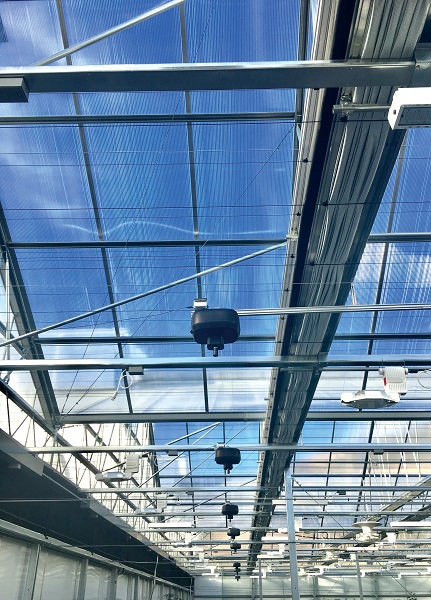
When chief executive officer and co-founder Adam Greenberg began developing the algorithms and other core components in 2012, he built them into the grow lights because he believed the lights were what would attract customers. Eventually he realized customers were most interested in the AI and data analysis functions, so that’s where he concentrated robustness.
“We wanted to build a system to be able to see and measure every single plant, and then we could do full and automated inventory tracking,” said Greenberg. “From a growing perspective is where it gets really fun. Now, not only do you have automated inventory tracking, so when you move your plants it automatically updates on your stock map, but then we can stitch it all together. We worked with some people from NASA and from Intel to stitch some of these together to the point where you get four pixels per millimeter or more across your entire farm with every single plant without ever having to go between an image. It’s all stitched together and loads as you zoom in, just like Google Maps. And then we realized you can search all these images and be able to see all the issues, like pathogen detection.”
Beyond capturing detailed images, the software also continuously builds detailed models of individual plants and has learning capabilities that are designed to help growers identify threats faster and optimize germination and growth rates. Once the images are stored in the system, the operator can detect any issues—powdery mildew, pests, light burn, etc.—and address them immediately, before the damage spreads. With less time spent addressing problems, Greenberg said, growers can spend more time focusing on compelling opportunities like identifying the best phenotypes in the room and increasing crop yields.
“THC is one thing you want to measure, but you also might want to know when the hairs change colors or how the fan leaves are looking; know how much extra extraction value you can get from fan leaves in comparison. If you can visually see it, we can measure it,” he said. “People want to start looking at the growth rate of flowers, so if I want to get an early harvest strain, well now we have a whole compare mode and analysis mode. It’s a whole phenotyping tool that allows you to do comparative analysis of all plant features of every single inventory item you’ve ever grown underneath the system.”
Greenberg believes greenhouse products are the future of the cannabis industry, and data-driven applications like LUNA will become standard tools to manage and maintain these industrial-scale grow operations effectively. To illustrate the advantages from a return-on-investment (ROI) perspective, he revealed the system belonging to one customer in Oregon caught a powdery mildew outbreak, causing the grower to remark, “Wow, this thing has already paid for itself for the next ten years.” The entire room might have been lost if the mildew had spread. “The other way [customers see financial benefit] is by honing their [standard operating procedures] and doing continuous improvement and getting the ROI through increased yields, increased efficiencies, risk mitigation, and downside protection, especially in large-scale facilities,” Greenberg said. “From that perspective, now you have scalability as well as the ability to be everywhere all at once with your best people. It allows them to get the ROI of higher quality throughout the whole facility.”
While there is little doubt technology will play a major role in the future of the cannabis industry, the bigger question is where and how it will make the biggest impact. Robots, drones, and artificial intelligence surely will be an important part of the equation, but it will be up to cannabis operators to decide how to employ the new tools in the most effective ways for their business needs.
“The ultimate goal of production is to eliminate all limiting factors so the genetic potential of the plants is able to fully shine,” said Flannery. “That’s nearly impossible, but it’s a lofty goal that we are going toward.”







